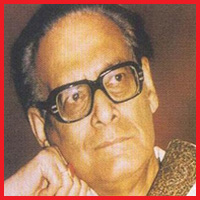Hemanta Mukhopadyay
Late Hemanta Mukhopadhyay

Late Hemanta Mukhopadhyay: 16 June, 1920 – 26 September, 1989
Hemanta Mukhopadyay was born in the city of Varanasi, India. His family hailed from a village named Baharu in West Bengal and migrated to Calcutta in the early 20th century. He too grew up in Calcutta and attended a school in South Calcutta(Bhawanipore) named Mitra Institution. There he met his longtime friend, a celebrated Bengali poet, Subhas Mukhopadhyay. After passing the intermediate examinations (12th grade) Hemanta Mukhopadhyay was admitted to Jadavpur University to study engineering. However, despite parental objection, he quit academics to pursue a career in music. He briefly tried his hand at literature and also published a short story in a prestigious Bengali magazine called ‘Desh’, but by the late-1930s he was committed entirely to music.Early music career:
Under the influence of his friend Subhash Mukhopadhyay, Hemanta Mukhopadhyay recorded his first song for All India Radio in 1933. The first line of the song was ‘aamaar gaane te ele naba ruupe chirantanii’. His music career was mentored by the Bengali musician Sailesh Duttagupta. His first Hindi songs were ‘kitanaa dukh bhulaaya tumane’ and ‘o priit nibhaabewaalii’, released in 1940 under GCI’s Columbia label. Music for these songs were composed by Kamal Dasgupta, lyrics were by Faiyaz Hashmi. His first film song was in the Bengali film ‘Nimai Sanyas’ released in 1941. Music for this film was scored by Hariprasanna Das. His first compositions for himself were the Bengali non-film songs ‘katha koyonako shudhu shono’ and ‘amar biraha aakaashe priyaa’ in 1944. Lyrics were by Amiya Bagchi. His first Hindi film songs were in Iraadaa in 1944 under Pt. Amarnath’s music direction. Lyrics were by Aziz Kashmiri. Hemanta is considered a foremost exponent of Rabindrasangeet(Tagore song) – songs (and lyrics) composed by the India’s first Nobel laureate, Rabindranath Tagore. He recorded his first Rabindrasangeet disc in 1944 under the Columbia label. The songs were ‘prangane mor shiriishh shaakhaay’ and ‘he nirupamaa’. His first movie as a music director was the Bengali film ‘Abhiyatri’ in 1947.Although many of the songs He recorded in during this time received critical acclaim, major commercial success still eluded him, right until 1947.
In September 1989, He travelled to Dhaka, Bangladesh to receive the Michael Madhusudan Award. He performed a concert in Dhaka as well. Immediately after returning from this trip, he suffered a major cardiac arrest on September 26th and breathed his last at 11:15 pm in a nursing home in South Calcutta. Interestingly, even 19 years after his death, Gramophone Company of India releases at least one album by Hemanta Mukhopadhyay every year, repackaging his older songs, because of the commercial viability of his songs. His legacy still lives on through the numerous songs he has recorded, music he has composed and through many male singers in Bengal and the rest of India who continue to imitate his singing style.
His wife wrote some lines for us on 17th December, 1989:
Translated English Testimonial: My husband Shri Hemanta Mukhopadhyay had a special liking for the Harmonium instrument of Calcutta Musical Depot.
Bela Mukhopadhyay, 17th December’ 1989.
